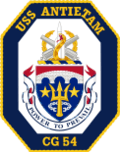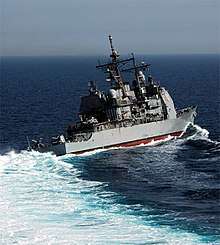USS Antietam (CG-54)
USS Antietam (CG-54) is a Ticonderoga-class guided missile cruiser of the United States Navy. Antietam was named for the site of the 1862 Battle of Antietam, Maryland, between Confederate forces under General Robert E. Lee and Union forces under Major General George McClellan, during the American Civil War. Antietam earned the 2007 and 2008 Battle Efficiency awards, also known as the Battle E award, for the John C. Stennis Strike Group. Antietam was out of operation for a while after running aground while trying to anchor in Tokyo Bay in January 2017.
_underway_2004.jpg) Antietam underway after leaving its homeport of San Diego, CA in 2004 | |
| History | |
|---|---|
| Name: | Antietam |
| Namesake: | Battle of Antietam |
| Ordered: | 20 June 1983 |
| Builder: | Ingalls Shipbuilding, Pascagoula, Mississippi |
| Laid down: | 15 November 1984 |
| Launched: | 14 February 1986 |
| Commissioned: | 6 June 1987 |
| Homeport: | Yokosuka, Japan |
| Identification: |
|
| Motto: | Power to Prevail |
| Status: | in active service |
| Badge: |
 |
| General characteristics | |
| Class and type: | Ticonderoga-class guided missile cruiser |
| Displacement: | Approx. 9,600 long tons (9,800 t) full load |
| Length: | 567 feet (173 m) |
| Beam: | 55 feet (16.8 meters) |
| Draught: | 34 feet (10.2 meters) |
| Propulsion: |
|
| Speed: | 32.5 knots (60 km/h; 37.4 mph) |
| Complement: | 30 officers and 300 enlisted |
| Sensors and processing systems: |
|
| Armament: |
|
| Aircraft carried: | 2 × Sikorsky SH-60B or MH-60R Seahawk LAMPS III helicopters. |
Construction
Antietam was laid down by the Litton-Ingalls Shipbuilding Corporation at Pascagoula, Mississippi, on 15 November 1984, launched on 14 February 1986, and commissioned on 6 June 1987 in Baltimore, Maryland.
Tours
From 1988 to 1991, the ship was assigned to Naval Surface Group, Long Beach, which was part of Commander, Naval Surface Forces Pacific.
Capability
The ship is armed with guided missiles and rapid-fire guns. She also carries two Sikorsky SH-60 Seahawk LAMPS helicopters, capable of multiple missions, but primarily equipped for antisubmarine warfare (ASW).
Ship history

In March 2003, Antietam was assigned to Carrier Group Three.[1]
Antietam operated out of her home port of San Diego, Calif. In 2009, she completed a six-month deployment, leaving San Diego in January 2009, and returning home in July 2009. Stops along the way included Hong Kong, Japan, South Korea, Singapore, Thailand, Guam, and Hawaii.
From January to August 2007, Antietam deployed to the Persian Gulf. During that seven-month deployment, she visited Dubai, Singapore, Hong Kong, and Pearl Harbor before returning to home port.
From February to August 2005, Antietam completed a circumnavigation of the Earth, leaving San Diego to the west and returning home by way of the east. During the deployment, she had an extended stay in the Persian Gulf as part of Operation Iraqi Freedom. On the return to home port, she disembarked nearly a third of her active personnel in Florida to make room for family and friends of the remaining crew, who embarked in Puerto Vallarta, Mexico, to take part in a friends and family "tiger cruise" back to San Diego.
_underway_in_the_rough_seas_of_the_East_China_Sea.jpg)
In February 2013, Antietam relieved USS Cowpens in a "hull-swap" at Yokosuka, Japan, in which the two crews swapped ships. Cowpens, previously deployed to Yokosuka, was then homeported at Naval Base San Diego, California, while Antietam took up her new homeport at Yokosuka.[2] On 31 January 2017, Antietam ran aground in Tokyo Bay near her home port of Yokosuka, Japan. Antietam was anchored off the coast in 30-knot winds and a strong tide when the crew noticed the ship was dragging its anchor. They got the ship underway, but shortly after doing so, they felt the ship shudder as it lost all pitch control in both propellers. They had run aground on a shoal with damage to both propellers and one of the propeller hubs, causing 1,100 US gallons (4,200 l) of hydraulic oil to leak into the water.[3][4] No personnel were injured during the incident.[5] Repairs were expected to cost at least $4.2 million.[6]
On 22 October 2018, she transited the Taiwan Strait along with USS Curtis Wilbur.[7] On 24–25 July 2019, she again transited the Taiwan Strait.[8] On 19-20 September 2019 she transited the Taiwan Strait a third time. [9]
Awards
- Navy Unit Commendation - (Aug-Nov 1990)
- Navy Meritorious Unit Commendation - (Dec 1998-May 1999, Feb-Sep 2003, Apr-Jun 2005, Apr 2012-Dec 2013)
- Battle "E" - (1990, 1994, 1995, 2000, 2003, 2007, 2008, 2014, 2015)[10]
- Southwest Asia Service Medal - (Au-Nov 1990)
References
- "World Navies Today: US Navy Aircraft Carriers & Surface Combatants". Hazegray.org. 10 March 2003. Retrieved 1 February 2017.
- Kelly, Paul (6 February 2013). "USS Antietam and USS Cowpens Complete Hull Swap In Japan". US Navy. Retrieved 1 February 2017.
- LaGrone, Sam (1 February 2017). "USS Antietam Likely Headed to Dry Dock for Repairs, 1,100 Gallons of Hydraulic Oil Still Missing". usni.org. Retrieved 20 June 2017.
- Cohen, Zachary (1 February 2017). "USS Antietam guided-missile cruiser runs aground, leaks oil". CNN. Retrieved 1 February 2017.
- Larter, David B. (31 January 2017). "Officials: Navy cruiser ran aground near Japan". NavyTimes. Retrieved 1 February 2017.
- TYLER HLAVAC (1 August 2017). "Navy probe blames captain's judgment in USS Antietam grounding". STARS AND STRIPES.
- "Two U.S. Navy warships sail through Taiwan Strait". 22 October 2018. Retrieved 22 October 2018.
- Ryan Browne (24 July 2019). "US Navy sails warship through contested waterway as Beijing warns Taiwan". CNN. Retrieved 25 July 2019.
- Matthew Strong (20 September 2019). "US Navy guided missile cruiser sails through Taiwan Strait". Taiwan News. Retrieved 4 February 2020.
- https://awards.navy.mil/awards/webapp01.nsf/(frmQUnitAwards)?OpenForm&Search=<UName>ANTIETAM CG 54</UName><sort>1</sort>
This article includes information collected from the Naval Vessel Register, which, as a U.S. government publication, is in the public domain.
External links
| Wikimedia Commons has media related to USS Antietam (CG-54). |